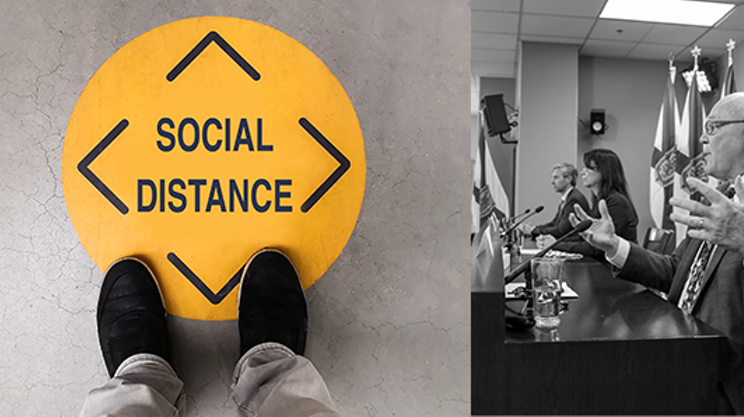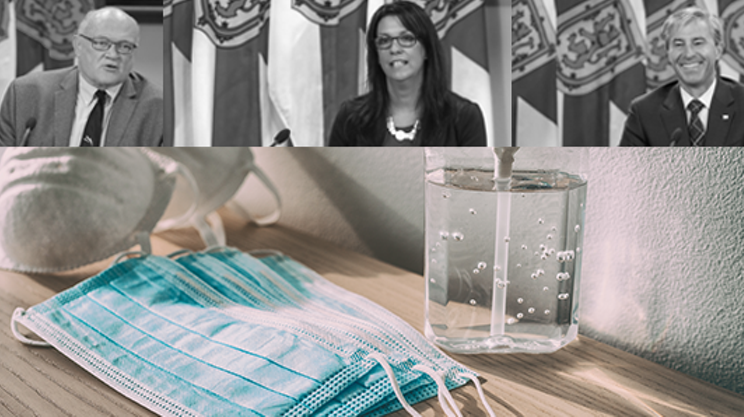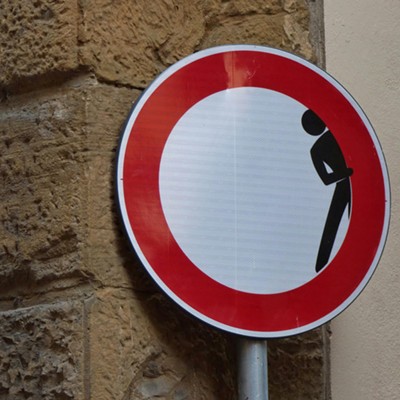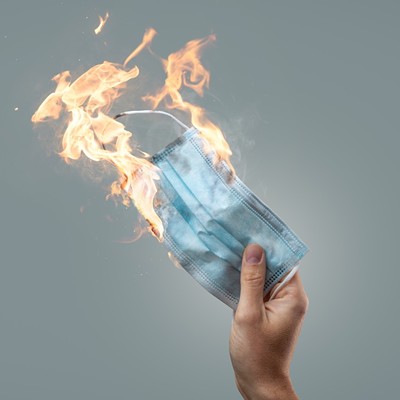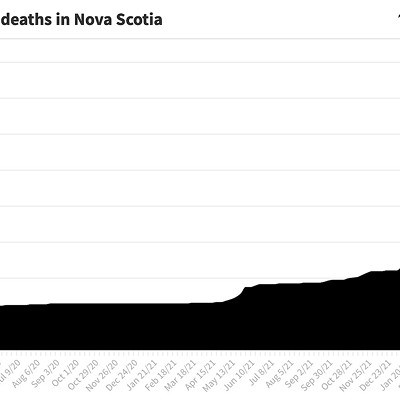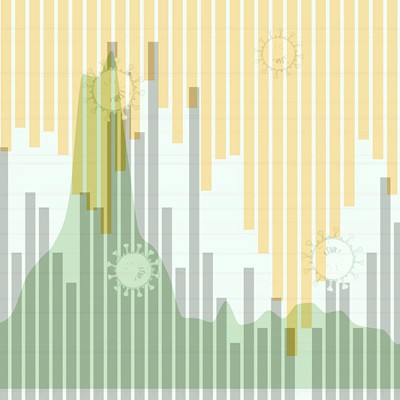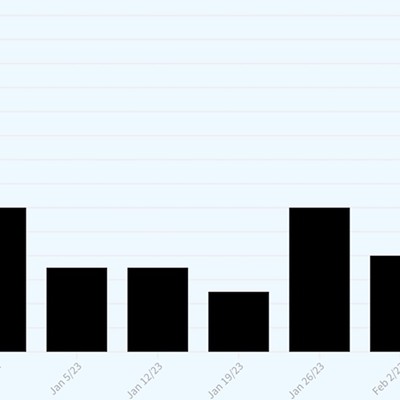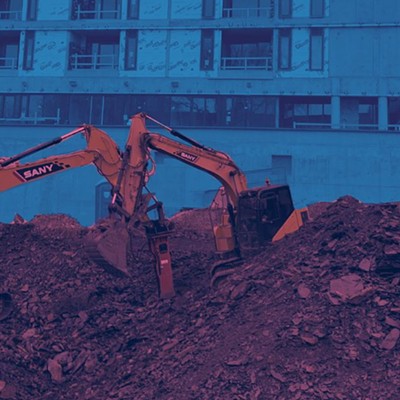COVID kills another Nova Scotian
This week is off to an awful start. After the province announced four COVID deaths Monday, today there's another, the 122nd official fatality of Nova Scotia's pandemic. The woman who died lived in the Eastern zone, and was in her 80s.
"Today, we lost another Nova Scotian to this virus, and I offer my prayers and condolences to the family and loved ones of the woman who passed," says Doctor Strang in Tuesday's provincial update. "Every person we lose is a reminder that COVID-19 persists as a very real threat. It hurts me to know that another family is grieving the loss of a loved one before their time."
Have we passed the peak?
Yesterday we pointed out how the low case number—495 new infections—wasn't necessarily a good sign because it came on a low number of tests, and the "positivity rate" was actually the highest it's ever been. But today we can say the low case number—the province is reporting a piddling 415 new cases—comes with plenty of tests and a low positivity rate of 12 percent. And that is a great sign.
With infections dropping and the province now down to an estimated 5,511 active cases, we can't help but look at the caseload graph and cautiously wonder if we have passed the peak. Nova Scotia reached an estimated 6,906 active cases on Monday, Jan 10, the maximum reported here during the pandemic years. This downward trend is mirrored in the Canada-wide infection numbers, which have come down since hitting an all-time high Jan 7.
Even if we are on the right side of the fourth wave of infections, we aren't out of the woods yet. Hospitalizations lag behind infections (typically a case is confirmed by the lab and then it takes days or even weeks for the disease to develop to the point where a person becomes sick enough to go to the hospital), and they are still on the rise. Today the province is reporting 73 patients in a designated hospital COVID unit, the same as yesterday, but total disease-related infections are up to 256. (Our graph of hospitalizations is below.) And the number of those COVID patients sick enough to need intensive care is up from 13 yesterday to 15 today.
Plus the way omicron spreads, infections could easily ramp back up if left unchecked. It's not much of a coincidence that that Jan 10 peak comes about two weeks—a standard COVID infection cycle—after Nova Scotia imposed new gathering restrictions aimed at slowing the speedy variant down. The semi-lockdown isn't scheduled to end until two weeks from today, which should mean good things for our numbers. But will they be low enough that we can dare to reopen into omicron's world?
Houstrang speaking tomorrow
Premier Tim Houston and chief medical officer of health Robert Strang will be giving a COVID briefing Wednesday, Jan 19, at 3pm. You can watch live at novascotia.ca/stayinformed/webcast and/or @nsgov on Facebook, or catch it later at the Nova Scotia government's YouTube page.
Hospitalizations during omicron
Early in 2022, Nova Scotia subtly shifted attention from new COVID cases to people actually in hospital with the disease, and as part of that shift started reporting the vaccination status of patients "receiving specialized care in a COVID-19 designated unit." On Jan 12—the day the bars on the following chart jump way up—the province added two more categories of hospitalized COVID patient to its daily reports. One is "people who were identified as positive upon arrival to hospital but were admitted for another medical reason or people who were admitted for COVID-19 but no longer require specialized care." (These patients are categorized as "Non-severe COVID case" on the chart.) The other category is category is "people who contracted COVID-19 after being admitted to hospital," as the province puts it, termed "Caught COVID in hospital" on the chart. You can filter categories in and out by clicking the labels near the top of the chart, but whatever numbers you are considering, the province points out it's "important to note that less than 10 percent of Nova Scotians are unvaccinated."
jump back to the top
Comparing active cases in the third and fourth waves
In December, the town of Antigonish became ground zero for an inter-provincial COVID outbreak due to a weekend of superspreader events connected to the annual presentation of X-Rings at St. Francis Xavier University. But how bad is the outbreak, really? The following chart lets you compare Nova Scotia's active cases, dating from the third wave in April through the fourth wave and its infection Xplosion, using case data from provincial pandemic reports. The chart will be updated when provincial reporting allows. Note: From Dec 10 through Dec 22, Nova Scotia was too overwhelmed by new COVID cases to report recoveries or an official active case count; the active case numbers on this graph for those dates have been calculated by adding each day's new cases to the last official active count, and are therefore a maximum active caseload. Starting Dec 23, the province is issuing an "estimated" number of active cases.
jump back to the top
New and active cases visualized
Nova Scotia's third wave of COVID grew in April, 2021, peaked in May (227 new cases in one day was the maximum) and subsided in June. On July 17, the province reached five active cases—its lowest level in more than eight months—and an election was called. So when it came time to reset The Coast's chart comparing daily new cases with that day’s active caseload, in order to better reflect disease levels after the third wave, we started from July 17. Two months later, on September 14, the province formally announced the arrival of the fourth wave of COVID. The dark purple line tracks the rise and fall of daily new infections reported by the province; the green area is the province's caseload. In mid-November, The Coast added a golden line to show the 7-day moving average of daily new cases, effectively a smoothed-out version of the purple line that puts the ups and downs into bigger context. Click or hover over any point on the graph and the detail for that moment will pop up. To focus on just some information, click the legend at the top left of the graph to hide or reveal that data set. Note: As of July 23, 2021, the province stopped updating case numbers on weekends. And you can click here for the version of this graph that includes the third wave and its May 10 crest of 1,655 active cases. Also, from Dec 10 through Dec 22, Nova Scotia was too overwhelmed by new COVID cases to report recoveries or an official active case count; the active case numbers on this graph for those dates have been calculated by adding each day's new cases to the last official active count, and are therefore a maximum active caseload. Starting Dec 23, the province is issuing an "estimated" number of active cases.
jump back to the top
Canadian cases 2021-22
There was a point in July 2021, when the delta variant was causing an increase in COVID infections around the world, that Canada seemed safe from the fourth wave. By August, however, that point had passed, and case numbers around the country started to rise again. This graph charts the number of new infections every day in each province and territory, using the 7-day moving average to mitigate single-day anomalies (including a lack of weekend reporting in several jurisdictions including British Columbia and Nova Scotia). To focus on individual places, click the place names at the top of the chart to turn that data on or off.
jump back to the top
Click here for yesterday's COVID-19 news roundup, for January 17, 2022.




